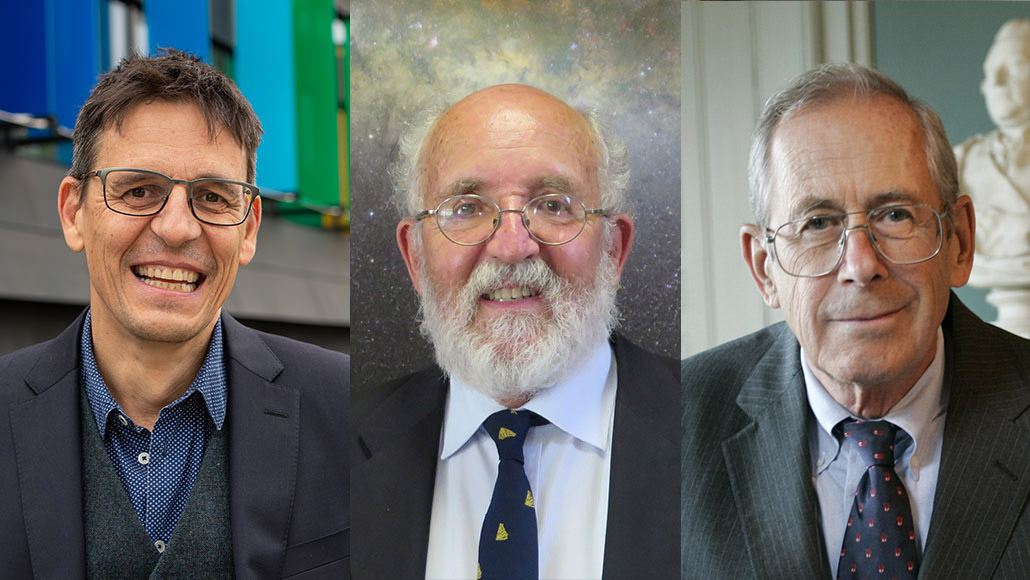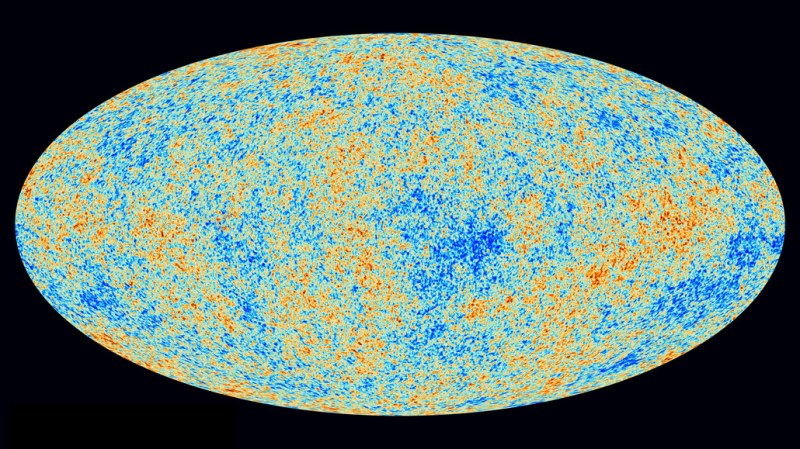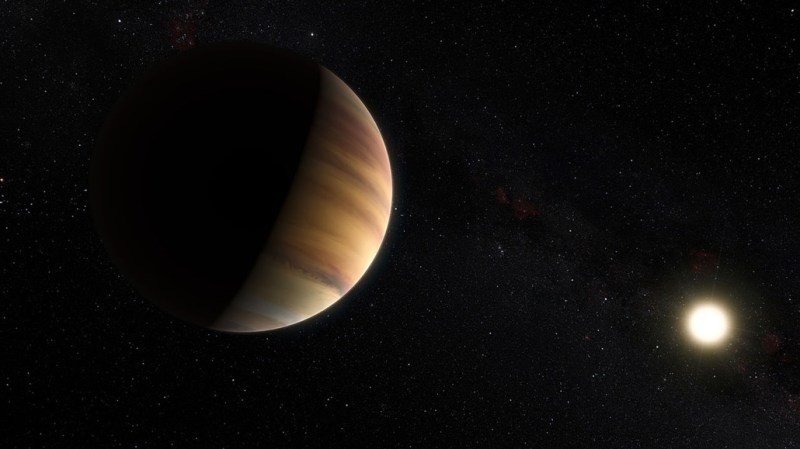
From left: University of Cambridge; Courtesy of Inamori Foundation; Torbjörn Zadia/ROYAL SWEDISH ACADEMY OF SCIENCES
Two sets of cosmic discoveries have garnered the 2019 Nobel Prize in physics.
Half of the prize of 9 million Swedish kronor (about $900,000) goes to James Peebles of Princeton University, who discovered new theoretical tools to study the universe. His research includes studies of the cosmic microwave background, or CMB, light emitted early in the universe’s history. The work eventually helped to reveal the mysterious components of the cosmos — dark matter and dark energy.
The second half of the prize is awarded to Michel Mayor of the University of Geneva and Didier Queloz of the University of Geneva and the University of Cambridge, for the first discovery of an exoplanet orbiting a solar-type star (SN: 11/25/95). That finding has reshaped scientists’ understanding of our cosmic neighborhood.
Both discoveries reveal fundamental components of the universe that are invisible to human eyes. Peebles’ work helped establish that only 5 percent of the contents of the universe is the ordinary matter that makes up planets and people (SN: 7/24/18). The rest is both dark matter (about 27 percent), which scarcely touches ordinary matter except through gravity, and dark energy (about 68 percent), which forces the universe to expand ever faster.
The discovery of the CMB won a Nobel Prize in 1978 (SN: 10/21/78), and discovery of dark energy won a Nobel Prize in 2011 (SN: 10/4/11).
Using a cup of coffee as a metaphor for the early universe, Nobel committee member and physicist Ulf Danielsson described ordinary matter as the bit of sugar sprinkled into the swirling liquid, representing dark matter and dark energy. That small sprinkle of matter “is what science has been all about for thousands of years — up until now,” he said.
Through Peebles’ work, “cosmology evolved into a science of precision,” Danielsson said.

Physicists lauded Peebles after the award announcement. “Jim is among the fathers of physical cosmology that laid the foundation for the now remarkably successful standard theory of the structure and history of the universe,” said physicist David Gross, president of the American Physical Society, in an email.
That standard theory of the universe is known as lambda-CDM. Peebles “has his fingerprints all over that,” says cosmologist Michael Turner of the University of Chicago. “He’s been involved in every major development in cosmology over the past 50 years.”
Cosmologist Jo Dunkley, a colleague of Peebles’ at Princeton, sums up the reaction of cosmologists at the university: “Yes, of course he got the Nobel Prize. He made this field.”
In a news conference held later in the day at Princeton, Peebles seemed overwhelmed by the recognition from his colleagues. “Now I know how rock stars feel,” he quipped. He noted that plenty of questions remain in cosmology, like the identity of dark matter and dark energy. “We can be very sure that as we discover new aspects of the expanding and evolving universe we will be startled and amazed once again.”
After the Big Bang 13.8 billion years ago, the nascent universe was a nearly uniform slurry, with only small variations in the density of matter. Peebles’ work explains how the universe transformed over eons to a cosmos filled with complex structures like galaxies, as a result of the prevailing pull of gravity. “He was one of the key people who developed the entire framework of structure formation,” says Priyamvada Natarajan of Yale University. Peebles showed that “dark matter was in the driver’s seat.” The influence of the still-undetected dark matter particles was essential to forming the structures of the cosmos observed today.
Structures in the universe formed along a wide range of size scales, resulting in not only enormous objects like galaxy clusters, but also smaller denizens within them, such as stars and their planets — including the exoplanet discovered by Mayor and Queloz. Honoring both these discoveries, Natarajan says, is “a celebration of human understanding of the largest scales and the smallest scales. Both are frontiers.”
Like dark matter and dark energy, Mayor and Queloz’s discovery — the first exoplanet around a sunlike star — was also not visible directly. In 1995, Mayor and Queloz found a Jupiter-mass planet orbiting the star 51 Pegasi by watching the way the planet tugged on the star. The planet’s gravity made the star wobble back and forth slightly, making the starlight shift from slightly bluer to slightly redder as the star moved toward and away from Earth.
That first planet, 51 Pegasi b, was unlike anything that exists in our solar system. It lies closer to its star than Mercury does to the sun. Scientists thought it was impossible for giant planets to form so close to their stars, until they found one.

Astronomers now think giant planets probably form far from their stars and migrate inward to become hot Jupiters. The idea that planets can shuffle around their orbits has since been used to explain some mysteries of our own solar system (SN: 5/25/05).
“This [migration] was a major ingredient of the scenario of planetary formation, and today all scenarios have to include these kind of phenomena,” Mayor said in an interview posted online October 8 by nobelprize.org.
When Queloz learned that their discovery had won, he “stopped breathing,” he told nobelprize.org. “I’m still completely stunned by the news.”
Since the discovery of 51 Pegasi b, more than 4,000 exoplanets have been found orbiting distant stars. Astronomers can now study individual planetary systems and planet populations as a whole to understand how alien worlds form and evolve. Scientists also are planning how to search for signs of life in exoplanets’ atmospheres (SN: 10/4/19).
“There’s a reason [51 Pegasi b] was found first — it’s the easiest type of planet to find,” says exoplanet scientist David Charbonneau of Harvard University. Big, close-orbiting planets have the largest influence on their stars.
Since 51 Pegasi b, “astronomers have been moving toward smaller planets and cooler planets” that are more like Earth, Charbonneau says. “There’s an enormous amount of enthusiasm in the field that, with the right telescopes, we really could … find out whether or not there’s life on other planets.”
Charbonneau says “it’s about time” for exoplanet science to be recognized with a Nobel Prize. “The community has really agreed that the discovery of 51 Peg was the discovery that really ignited the field,” he says.
Other exoplanet scientists were more surprised. Sara Seager of MIT did not expect her field to win the top honor. “I was so floored,” she says.
The prize is a huge boost for exoplanet science, which some still see as “a frivolous, almost stamp collecting endeavor,” she says. In just 25 years, “we went from being an obscure and laughable fringe to mainstream science that’s Nobel-worthy.”







